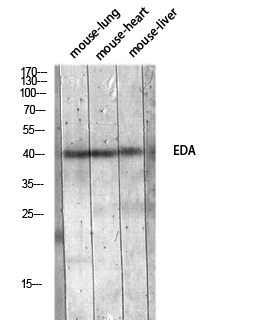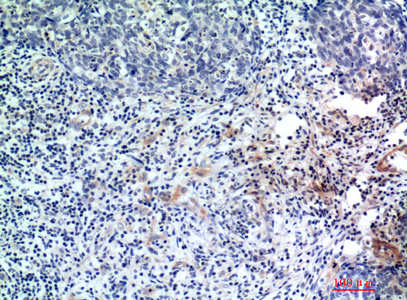产品名称
EDA Rabbit Polyclonal Antibody
别名
EDA; ED1; EDA2; Ectodysplasin-A; Ectodermal dysplasia protein; EDA protein
存储缓冲液
Liquid in PBS containing 50% glycerol, 0.5% BSA and 0.02% New type preservative N.
Human Gene Link
http://www.ncbi.nlm.nih.gov/sites/entrez?db=gene&term=1896
Human Swissprot No.
Q92838
Human Swissprot Link
http://www.uniprot.org/uniprotkb/Q92838/entry
Mouse Gene Link
http://www.ncbi.nlm.nih.gov/sites/entrez?db=gene&term=13607
Mouse Swissprot No.
O54693
Mouse Swissprot Link
http://www.uniprot.org/uniprot/O54693
Rat Gene Link
http://www.ncbi.nlm.nih.gov/sites/entrez?db=gene&term=
Rat Swissprot Link
http://www.uniprot.org/uniprot/
免疫原
The antiserum was produced against synthesized peptide derived from the Internal region of human EDA. AA range:120-170
特异性
EDA Polyclonal Antibody detects endogenous levels of EDA protein.
稀释度
WB 1:500 - 1:2000. IHC-p: 1:100-1:300. ELISA: 1:10000.. IF 1:50-200
宿主
Polyclonal, Rabbit,IgG
背景介绍
The protein encoded by this gene is a type II membrane protein that can be cleaved by furin to produce a secreted form. The encoded protein, which belongs to the tumor necrosis factor family, acts as a homotrimer and may be involved in cell-cell signaling during the development of ectodermal organs. Defects in this gene are a cause of ectodermal dysplasia, anhidrotic, which is also known as X-linked hypohidrotic ectodermal dysplasia. Several transcript variants encoding many different isoforms have been found for this gene. [provided by RefSeq, Jul 2008],
组织表达
Not abundant; expressed in specific cell types of ectodermal (but not mesodermal) origin of keratinocytes, hair follicles, sweat glands. Also in adult heart, liver, muscle, pancreas, prostate, fetal liver, uterus, small intestine and umbilical chord.
细胞定位
Cell membrane ; Single-pass type II membrane protein .; [Ectodysplasin-A, secreted form]: Secreted .
信号通路
Cytokine-cytokine receptor interaction;
功能
alternative products:Additional isoforms seem to exist,disease:Defects in EDA are a cause of hypodontia [MIM:300606]. Hypodontia is agenesis of two or more permanent teeth without associated systemic disorders. Hypodontia due to EDA defects is an X-linked recessive disorder. Affected individuals have normal hair, skin, and nails, but lack primary and permanent teeth.,disease:Defects in EDA are the cause of ectodermal dysplasia, type 1 (ED1) [MIM:305100]; also known as Christ-Siemens-Touraine syndrome or X-linked hypohidrotic ectodermal dysplasia (XLHED). Ectodermal dysplasia defines a heterogeneous group of disorders due to abnormal development of two or more ectodermal structures. ED1 is a disease characterized by sparse hair (atrichosis or hypotrichosis), abnormal or missing teeth and the inability to sweat due to the absence of sweat glands. ED1 is the most common form of over 150 clinically distinct ectodermal dysplasias.,function:Seems to be involved in epithelial-mesenchymal signaling during morphogenesis of ectodermal organs. Isoform A1 binds only to the receptor EDAR, while isoform A2 binds exclusively to the receptor XEDAR.,PTM:N-glycosylated.,PTM:Processing by furin produces a secreted form.,similarity:Belongs to the tumor necrosis factor family.,similarity:Contains 1 collagen-like domain.,subunit:Homotrimer. The homotrimers may then dimerize and form higher order oligomers.,tissue specificity:Not abundant; expressed in specific cell types of ectodermal (but not mesodermal) origin of keratinocytes, hair follicles, sweat glands. Also in adult heart, liver, muscle, pancreas, prostate, fetal liver, uterus, small intestine and umbilical chord.,
纯化
The antibody was affinity-purified from rabbit antiserum by affinity-chromatography using epitope-specific immunogen.


